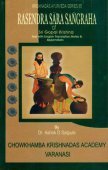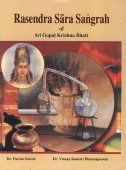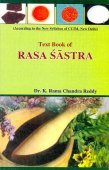Manahshila, Manaḥśilā, Manah-shila, Manas-shila, Mānaḥśila, Manaḥśila: 19 definitions
Introduction:
Manahshila means something in Hinduism, Sanskrit, Jainism, Prakrit. If you want to know the exact meaning, history, etymology or English translation of this term then check out the descriptions on this page. Add your comment or reference to a book if you want to contribute to this summary article.
The Sanskrit terms Manaḥśilā and Mānaḥśila and Manaḥśila can be transliterated into English as Manahsila or Manahshila, using the IAST transliteration scheme (?).
In Hinduism
Ayurveda (science of life)
Rasashastra (Alchemy and Herbo-Mineral preparations)
Source: Wisdom Library: Rasa-śāstra1) Manaḥśilā (मनःशिला):—Sanskrit technical term translating to “realgar”, which is an arsenic sulfide mineral occurring in monoclinic crystals. Its common name in english is “ruby sulphur”. Śilā is commonly found throughout Rasaśāstra literature (Medicinal Alchemy) such as the Rasaprakāśasudhākara or the Rasaratna-samuccaya. It is also known as Kunaṭī.
2) Manaḥśilā (मनःशिला, “realgar”):—One of the eight uparasa (‘secondary minerals’), a group of eight minerals, according to the Rasaprakāśasudhākara: a 13th century Sanskrit book on Indian alchemy, or, Rasaśāstra. It also known by the synonym Kunaṭi or simply Śilā.
There are two varieties of Realgar (manaḥśilā):
- Śyāma/Śyāmikā,
- Rakta (Kaṇavīrā)
- and Khaṇḍika
Manaḥśilā (Realger) is said to have three varieties:
- Śyāma (Śyāmikā),
- Rakta (Kaṇavīrā),
- Khaṇḍikā.
All the varieties are considered to possess best rasāyana property, it may destroy vāta and kapha-doṣa, possess more amount of satva, checks viṣa-prabhāva, prevents bhuta-bādhā (evil spirits effects), cures kaṇḍū (itching), kṣaya-roga, agnimāndya (sluggishness of digestive fire) and destroys koṣṭha-gata-rogas.
Source: Ancient Science of Life: A Metallurgical Study of Nāga BhasmaManaḥśilā (मनःशिला) refers to the chemical composition As2S2 and is used is in the metallurgical process for creating nāgabhasma, (Śodhana step):—Raw nāga (crude Lead-600 g) was subjected to śodhana by melting and pouring into a container of cūrṇodaka (lime water, strength 4.3 g/l) seven times. [...] The śodhana of Manaḥśilā (chemical composition As2S2) was done by subjecting it to seven bhāvanās (levigation) in Ārdraka (Zingiber officinale Linn.) svarasa.
Source: Ancient Science of Life: Critical Review of Rasaratna SamuccayaManaḥshilā (मनःस्हिला) refers to “realgar”, and mentioned in the Rasaratnasamuccaya: a 13th century C.E. alchemical treatise, authored by Vāgbhaṭa, is a useful compilation related to preparation and properties of drugs of mineral and metallic origin.—In different sections, the author has mentioned four drugs viz. Svarṇamākṣika (copper pyrite), Manaḥshilā (realgar), Vaikrānta (tourmaline) and Kānta Lauha (cast iron) as best rejuvenators among all other drugs.
Kalpa (Formulas, Drug prescriptions and other Medicinal preparations)
Source: Ancient Science of Life: Yogaśataka of Pandita VararuciManaḥśilā (मनःशिला) refers to “arsenic sulphide” and is dealt with in the 10th century Yogaśataka written by Pandita Vararuci.—The Yogaśataka of Pandita Vararuci is an example of this category. This book attracts reader by its very easy language and formulations (viz., manaḥśilā) which can be easily prepared and have small number of herbs. It describes only those formulations which are the most common and can be used in majority conditions of diseases.
Manaḥśilā (arsenic sulphide) and Iron has been recommended internally. Śilājatu is prescribed for Aśmari, Manaḥśilā in vomiting and Iron in Pāṇḍu.

Āyurveda (आयुर्वेद, ayurveda) is a branch of Indian science dealing with medicine, herbalism, taxology, anatomy, surgery, alchemy and related topics. Traditional practice of Āyurveda in ancient India dates back to at least the first millenium BC. Literature is commonly written in Sanskrit using various poetic metres.
Yoga (school of philosophy)
Source: Google Books: The Khecarividya of AdinathaRealgar (manaḥśilā) is red arsenic, an ingredient in elixirs. Picumata 46.57 includes manaḥśilā in a list of siddhis, and a Buddhist Kriyātantra (the Amoghapāśakalparāja) describes how manaḥśilā, when applied to the eyes, can make the wearer invisible and able to move in the ether. In the Kāmasūtra 7.2.46, it is said that if one coats one’s hand with the faeces of a peacock that has eaten haritāla and/or manaḥśilā and touches something, it becomes invisible.

Yoga is originally considered a branch of Hindu philosophy (astika), but both ancient and modern Yoga combine the physical, mental and spiritual. Yoga teaches various physical techniques also known as āsanas (postures), used for various purposes (eg., meditation, contemplation, relaxation).
Kavya (poetry)
Source: archive.org: Naisadhacarita of SriharsaManaḥśilā (मनःशिला) refers to “red arsenic”, and is mentioned in the Naiṣadha-carita 15.28, 33.—The poet refers to an ornamental dot of red arsenic on the forehead of the bride. Similar uses of manaḥśilā are referred to in Vidagdhamādhava 7.33; in Kādambarī (Pūrvabhāga); in Padmaprābhṛtaka.
Manaḥśilā was used also for medicinal purposes. Rājanighaṇṭu gives rogaśilā as one of its names.

Kavya (काव्य, kavya) refers to Sanskrit poetry, a popular ancient Indian tradition of literature. There have been many Sanskrit poets over the ages, hailing from ancient India and beyond. This topic includes mahakavya, or ‘epic poetry’ and natya, or ‘dramatic poetry’.
Shaivism (Shaiva philosophy)
Source: SOAS University of London: Protective Rites in the Netra TantraManaḥśilā (मनःशिला) refers to “red arsenic”, according to the Svacchanda-tantra.—Accordingly, [verse 4.8-13, while describing auspicious dreams]—“[...] [It is auspicious when one dreams of] a pill, wood for cleaning the teeth, yellow pigment on a sword or sandal, sacred thread, ointment, nectar, mercury, medicinal herbs, śakti, a water jar, lotus, rosary, red arsenic (manaḥśilā) or blazing objects of siddhas, which have red chalk as their ends. [...]”

Shaiva (शैव, śaiva) or Shaivism (śaivism) represents a tradition of Hinduism worshiping Shiva as the supreme being. Closely related to Shaktism, Shaiva literature includes a range of scriptures, including Tantras, while the root of this tradition may be traced back to the ancient Vedas.
In Jainism
General definition (in Jainism)
Source: archive.org: Economic Life In Ancient India (as depicted in Jain canonical literature)Manaḥśilā (मनःशिला) refers to “arsenic” or “realgar”: a mineral that was typically mined, extracted and used (both domestic and industrial) in ancient India. Mining was an important industry at that time as well. The Jaina canonical texts mention about the extraction of various kinds of minerals, metals and precious stones. The term ‘āgara’ occurring intire texts denotes the mines which provided many kinds of mineral products (e.g., manaḥśilā). The references in the texts of various professions and trade in metallic commodities clearly show a highly developed industry of mining and metallurgy in that period.

Jainism is an Indian religion of Dharma whose doctrine revolves around harmlessness (ahimsa) towards every living being. The two major branches (Digambara and Svetambara) of Jainism stimulate self-control (or, shramana, ‘self-reliance’) and spiritual development through a path of peace for the soul to progess to the ultimate goal.
Languages of India and abroad
Sanskrit dictionary
Source: DDSA: The practical Sanskrit-English dictionaryMānaḥśila (मानःशिल).—a. Consisting of red arsenic (manaḥśilā).
--- OR ---
Manaḥśila (मनःशिल) or Manaḥśilā (मनःशिला).—red arsenic; मनःशिला- विच्छुरिता निषेदुः (manaḥśilā- vicchuritā niṣeduḥ) Kumārasambhava 1.55; R.12.8; टङ्कैर्मनःशिलगुहैरवदीर्य- माणा (ṭaṅkairmanaḥśilaguhairavadīrya- māṇā) Mk.; गन्धाश्मानं मनःशिलाम् (gandhāśmānaṃ manaḥśilām) Śiva B.3.19; मनःशिला- पङ्कलिखितेन च विद्योतितललाटपट्टाम् (manaḥśilā- paṅkalikhitena ca vidyotitalalāṭapaṭṭām) K.
Derivable forms: manaḥśilaḥ (मनःशिलः).
Manaḥśila is a Sanskrit compound consisting of the terms manas and śila (शिल).
Source: Cologne Digital Sanskrit Dictionaries: Shabda-Sagara Sanskrit-English DictionaryManaḥśila (मनःशिल).—mf.
(-laḥ-lā) Red arsenic. E. mans the mind, śilā a stone; mineral delightful to the mind or heart; also with the dental sa, manaḥsila . “manchāla .”
--- OR ---
Manaḥsila (मनःसिल).—mf.
(-laḥ-lā) Red arsenic: see the last.
Source: Cologne Digital Sanskrit Dictionaries: Benfey Sanskrit-English DictionaryManaḥśila (मनःशिल).—m., and f. lā, red arsenic. Svalpa-śilā, i. e.
Manaḥśila is a Sanskrit compound consisting of the terms manas and śila (शिल).
Source: Cologne Digital Sanskrit Dictionaries: Cappeller Sanskrit-English DictionaryManaḥśila (मनःशिल).—[masculine] [neuter] red arsenic.
--- OR ---
Manaḥśilā (मनःशिला).—[feminine] red arsenic.
Source: Cologne Digital Sanskrit Dictionaries: Monier-Williams Sanskrit-English Dictionary1) Manaḥśilā (मनःशिला):—[=manaḥ-śilā] [from manaḥ > man] f. (L. also la m.; cf. [compound]) realgar, red arsenic, [Mahābhārata; Kāvya literature] etc.
2) Manaḥsilā (मनःसिला):—[=manaḥ-silā] [from manaḥ > man] [wrong reading] for -śilā.
3) Mānaḥśila (मानःशिल):—mf(ī)n. consisting of realgar or red arsenic, [Mahābhārata]
Source: Cologne Digital Sanskrit Dictionaries: Yates Sanskrit-English Dictionary1) Manaḥśila (मनःशिल):—[manaḥ-śila] (laḥ-lā) 1. m. f. Red arsenic.
2) Manaḥsila (मनःसिल):—[manaḥ-sila] (laḥ-lā) 1. m. Idem.
Source: DDSA: Paia-sadda-mahannavo; a comprehensive Prakrit Hindi dictionary (S)Manaḥśilā (मनःशिला) in the Sanskrit language is related to the Prakrit words: Maṇaṃsila, Maṇaṃsilā.
[Sanskrit to German]
Sanskrit, also spelled संस्कृतम् (saṃskṛtam), is an ancient language of India commonly seen as the grandmother of the Indo-European language family (even English!). Closely allied with Prakrit and Pali, Sanskrit is more exhaustive in both grammar and terms and has the most extensive collection of literature in the world, greatly surpassing its sister-languages Greek and Latin.
Nepali dictionary
Source: unoes: Nepali-English DictionaryManaḥśilā (मनःशिला):—n. → मनैसिल [manaisila]
Nepali is the primary language of the Nepalese people counting almost 20 million native speakers. The country of Nepal is situated in the Himalaya mountain range to the north of India.
See also (Relevant definitions)
Partial matches: Shila, Manah, Manas, Cila.
Starts with: Manahshilacandanadhavana, Manahshilagiri, Manahshilaguha, Manahshilavicchurita.
Full-text (+11): Manahshilacandanadhavana, Manahshilavicchurita, Manahshilagiri, Manogupta, Manahshilaguha, Manohva, Khandika, Shyamika, Kanavira, Manahshiloccaya, Manashila, Gandhashman, Manamsila, Uparasa, Culuculayati, Badhyashila, Khutkhuta, Rasashastra, Manosila, Kunati.
Relevant text
Search found 19 books and stories containing Manahshila, Manaḥśilā, Manah-shila, Manas-shila, Mānaḥśila, Manaḥśila, Manahsila, Manas-śila, Manas-śilā, Manas-sila, Manaḥsila, Manaḥ-śilā, Manah-sila, Manaḥsilā, Manaḥ-silā, Manaḥ-śila, Manaḥ-sila; (plurals include: Manahshilas, Manaḥśilās, shilas, Mānaḥśilas, Manaḥśilas, Manahsilas, śilas, śilās, silas, Manaḥsilas, Manaḥsilās, silās). You can also click to the full overview containing English textual excerpts. Below are direct links for the most relevant articles:
Rasa Jala Nidhi, vol 2: Minerals (uparasa) (by Bhudeb Mookerjee)
Part 1 - Characteristics of Manahshila or Manas-shila (realgar) < [Chapter XIII - Uparasa (14): Manahshila or Manas-shila (realgar)]
Chapter XIII - Uparasa (14): Manahshila or Manas-shila (realgar)
Part 2 - Purification of manas-shila < [Chapter XIII - Uparasa (14): Manahshila or Manas-shila (realgar)]
The Garuda Purana (by Manmatha Nath Dutt)
Chapter CCIV - Various other medicinal Recipes (continued) < [Dhanvantari Samhita]
Chapter CCV - Various other medicinal Recipes (continued) < [Dhanvantari Samhita]
Chapter CXCIX - Various other medicinal Recipes < [Dhanvantari Samhita]
Rasa Jala Nidhi, vol 3: Metals, Gems and other substances (by Bhudeb Mookerjee)
Part 3 - Incineration of Lead < [Chapter VII - Metals (7): Sisaka (lead)]
Part 7 - Incineration of Diamonds, irrespective of colour < [Chapter XIII - Gems (1): Vajra or Hiraka (diamond)]
Part 4 - Extraction of essence of Rajavarta < [Chapter XXV - Gems (15): Rajavarta (quartz amethyst or lapis lazuli)]
Rasa Jala Nidhi, vol 1: Initiation, Mercury and Laboratory (by Bhudeb Mookerjee)
Part 1 - Additional process for transformation of base metals into gold and silver < [Chapter VIII - Conclusion of first volume]
Part 20 - Mercurial operations (18): Transformation of base metals into gold by mercury (bedhana) < [Chapter IV-V - Mercurial operations]
Part 15 - Mercurial operations (13): Internal liquefaction of mercury (garbhadruti) < [Chapter IV-V - Mercurial operations]
Sushruta Samhita, Volume 6: Uttara-tantra (by Kaviraj Kunja Lal Bhishagratna)
Chapter XIV - Treatment of eye-diseases which require Incision < [Canto I - Shalakya-tantra (ears, eyes, nose, mouth and throat)]
Chapter XXXV - Treatment of an attack by Mukha-mandika < [Canto II - Kaumarabhritya-tantra (pediatrics, gynecology and pregnancy)]
Chapter XXXII - Treatment of an attack by Putana-graha < [Canto II - Kaumarabhritya-tantra (pediatrics, gynecology and pregnancy)]
Sushruta Samhita, volume 4: Cikitsasthana (by Kaviraj Kunja Lal Bhishagratna)
Related products





